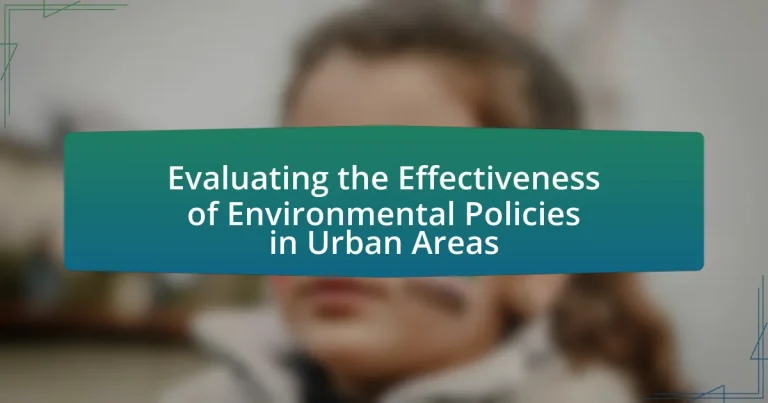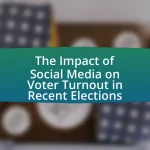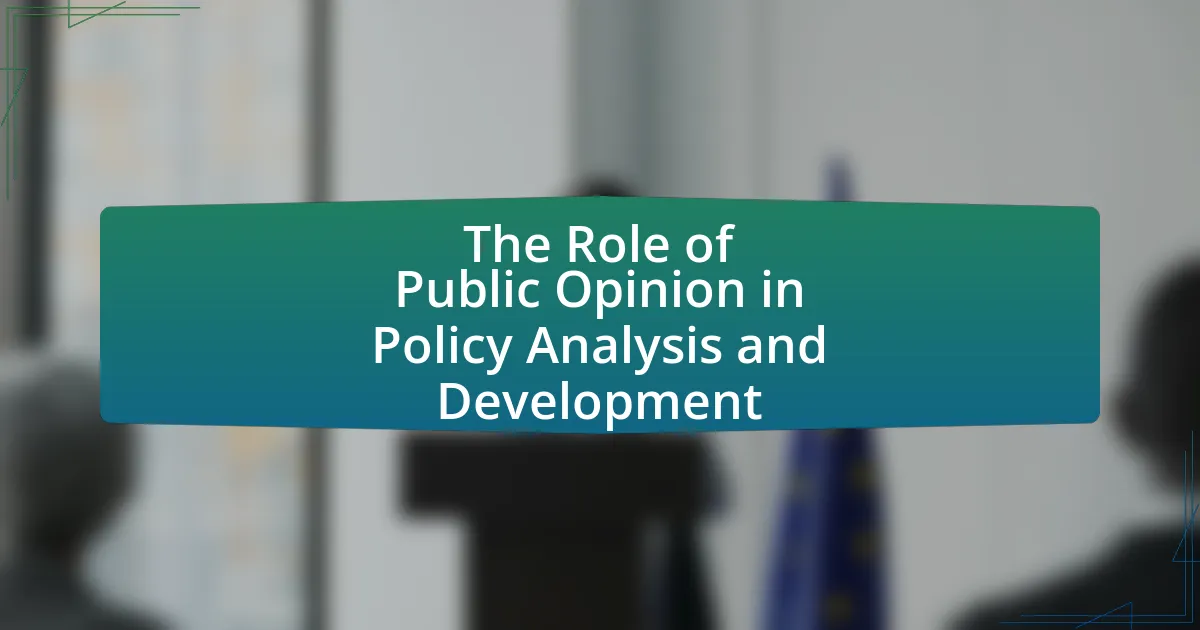The article focuses on evaluating the effectiveness of environmental policies in urban areas, which are essential regulations aimed at managing human impact on the environment. It discusses the various aspects these policies target, including air quality, waste management, and urban green spaces, and highlights their significant impact on sustainability and public health. The article also examines the methods used for evaluation, such as quantitative and qualitative analyses, and addresses the challenges faced in the evaluation process, including data availability and stakeholder engagement. Furthermore, it emphasizes the importance of continuous monitoring and stakeholder involvement in enhancing policy effectiveness and informs future urban sustainability initiatives.
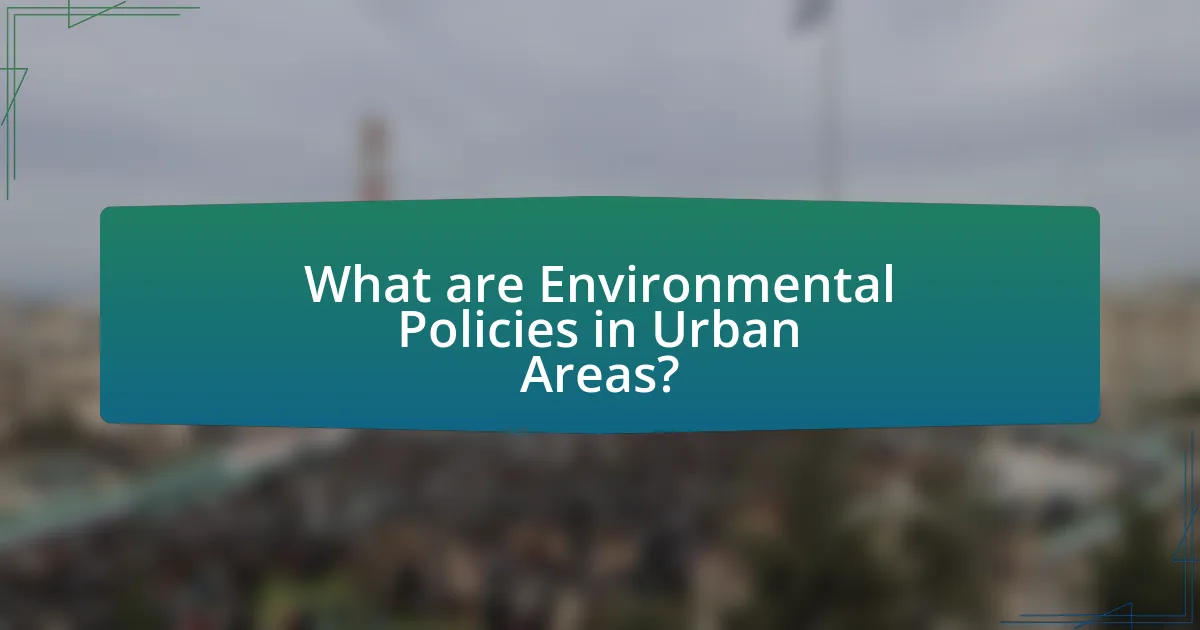
What are Environmental Policies in Urban Areas?
Environmental policies in urban areas are regulations and initiatives designed to manage human impact on the environment within city settings. These policies aim to address issues such as air and water quality, waste management, land use, and biodiversity conservation. For instance, cities may implement policies that promote sustainable transportation, such as public transit systems and bike lanes, to reduce greenhouse gas emissions. Additionally, urban areas often adopt zoning laws that encourage green spaces and limit industrial pollution. The effectiveness of these policies can be evaluated through metrics like reductions in pollution levels, improvements in public health, and increased green space per capita.
How do these policies impact urban environments?
Environmental policies significantly impact urban environments by promoting sustainability, reducing pollution, and enhancing public health. For instance, policies that encourage green spaces and urban forestry can lower urban heat islands, improve air quality, and provide recreational areas for residents. A study by the American Planning Association found that cities implementing green infrastructure saw a 30% reduction in stormwater runoff, which mitigates flooding and improves water quality. Additionally, regulations aimed at reducing vehicle emissions have led to improved air quality, with cities like Los Angeles reporting a 50% decrease in smog levels since the introduction of stricter air quality standards. These policies not only foster healthier living conditions but also contribute to the overall resilience of urban areas against climate change.
What specific areas do environmental policies target in urban settings?
Environmental policies in urban settings specifically target air quality, waste management, water resources, urban green spaces, and energy efficiency. These policies aim to reduce pollution levels, manage solid and hazardous waste, ensure sustainable water use, enhance urban biodiversity, and promote renewable energy sources. For instance, the Clean Air Act in the United States has led to significant reductions in urban air pollutants, demonstrating the effectiveness of targeted regulations in improving air quality. Additionally, cities implementing comprehensive recycling programs have reported increased waste diversion rates, showcasing the impact of effective waste management policies.
How do urban residents perceive these policies?
Urban residents generally perceive environmental policies as essential for improving their quality of life and addressing issues like pollution and climate change. Surveys indicate that a significant majority of urban dwellers support initiatives aimed at reducing emissions and enhancing green spaces, with studies showing that 70% of city residents favor stricter regulations on air quality. Additionally, many residents express concerns about the effectiveness of these policies, citing a lack of transparency and community involvement in decision-making processes. This perception is supported by research from the Urban Institute, which highlights that effective communication and public engagement are critical for fostering trust and compliance among urban populations regarding environmental initiatives.
Why is it important to evaluate the effectiveness of these policies?
Evaluating the effectiveness of environmental policies in urban areas is crucial to ensure that these policies achieve their intended outcomes. Effective evaluation allows policymakers to assess the impact of regulations on air quality, waste management, and biodiversity, thereby identifying successful strategies and areas needing improvement. For instance, a study by the Environmental Protection Agency found that cities implementing strict emissions regulations saw a 30% reduction in air pollutants over five years, demonstrating the tangible benefits of effective policy evaluation. This process not only enhances accountability but also informs future policy decisions, ensuring that resources are allocated efficiently to maximize environmental and public health benefits.
What criteria are used to measure effectiveness?
Criteria used to measure effectiveness of environmental policies in urban areas include environmental impact, economic viability, social equity, and compliance with regulations. Environmental impact assesses the degree to which policies reduce pollution and enhance biodiversity, often measured through metrics like air and water quality indices. Economic viability evaluates cost-effectiveness and the potential for sustainable funding, typically analyzed through cost-benefit analyses. Social equity examines the distribution of benefits and burdens among different demographic groups, ensuring that policies do not disproportionately affect marginalized communities. Compliance with regulations ensures that policies adhere to local, state, and federal environmental laws, which can be tracked through monitoring and reporting mechanisms. These criteria provide a comprehensive framework for assessing the overall effectiveness of environmental policies in urban settings.
How do evaluations influence future policy decisions?
Evaluations influence future policy decisions by providing data-driven insights that inform policymakers about the effectiveness of existing policies. For instance, when urban environmental policies are evaluated, metrics such as air quality improvements or reductions in greenhouse gas emissions are analyzed. These evaluations reveal which strategies are successful and which are not, guiding future policy formulation. Research conducted by the National Academy of Sciences in 2020 demonstrated that cities that regularly assess their environmental policies are more likely to implement successful initiatives, as they can adapt based on empirical evidence. Thus, evaluations serve as a critical feedback mechanism that shapes and refines policy decisions in urban environmental management.
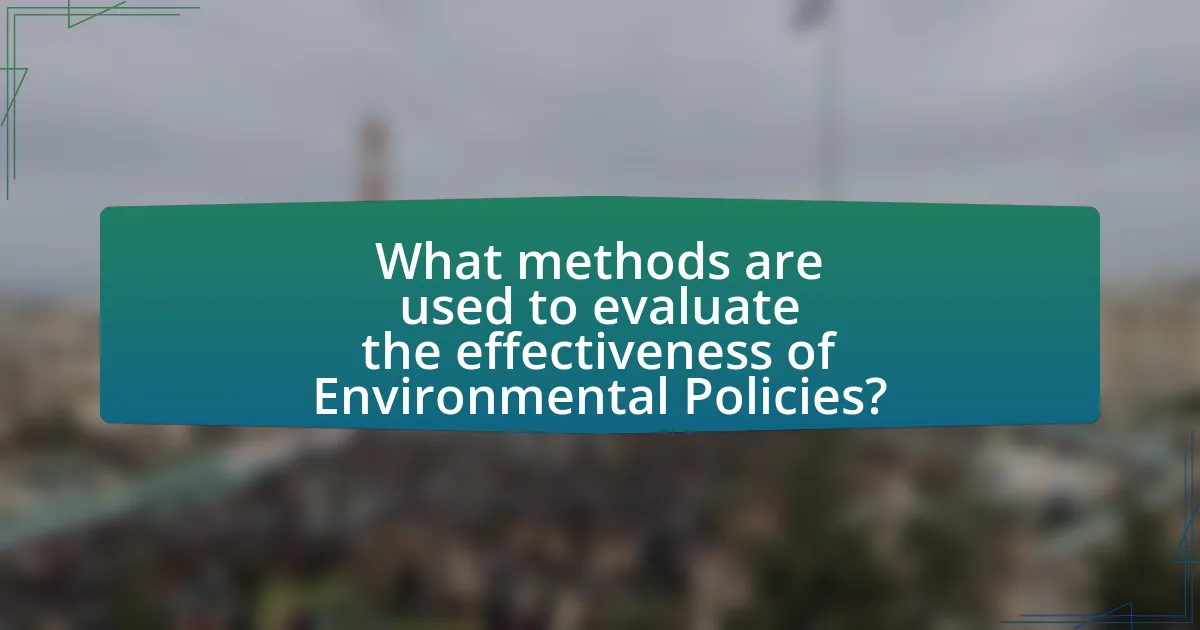
What methods are used to evaluate the effectiveness of Environmental Policies?
Methods used to evaluate the effectiveness of environmental policies include quantitative analysis, qualitative assessments, and case studies. Quantitative analysis often involves statistical methods to measure changes in environmental indicators, such as air quality or biodiversity, before and after policy implementation. For instance, the use of regression analysis can help determine the impact of specific regulations on pollution levels. Qualitative assessments, on the other hand, may include interviews and surveys to gather stakeholder perspectives on policy effectiveness. Case studies provide in-depth insights into specific instances of policy application, allowing for a comprehensive understanding of outcomes and challenges. These methods collectively offer a robust framework for assessing how well environmental policies achieve their intended goals in urban areas.
How do qualitative and quantitative methods differ in evaluations?
Qualitative and quantitative methods differ in evaluations primarily in their approach to data collection and analysis. Qualitative methods focus on understanding the underlying reasons, motivations, and experiences of individuals through interviews, focus groups, and observations, providing rich, descriptive insights. In contrast, quantitative methods emphasize numerical data and statistical analysis, allowing for the measurement of variables and the identification of patterns through surveys and experiments. For instance, a study evaluating urban environmental policies might use qualitative interviews to explore community perceptions, while employing quantitative surveys to assess the impact of those policies on air quality metrics. This distinction highlights how qualitative methods capture depth and context, whereas quantitative methods offer breadth and generalizability in evaluation outcomes.
What are the advantages of using qualitative methods?
Qualitative methods offer several advantages, particularly in understanding complex social phenomena such as the effectiveness of environmental policies in urban areas. These methods provide in-depth insights into participants’ perspectives, allowing researchers to capture the nuances of human behavior and social interactions that quantitative methods may overlook. For instance, qualitative interviews can reveal the motivations and barriers faced by community members regarding environmental initiatives, which can inform more effective policy design. Additionally, qualitative methods facilitate the exploration of contextual factors, such as cultural attitudes and local practices, that influence policy outcomes. This depth of understanding is crucial for tailoring interventions to specific urban settings, ultimately enhancing the effectiveness of environmental policies.
What role do quantitative methods play in policy evaluation?
Quantitative methods play a crucial role in policy evaluation by providing measurable data that can assess the effectiveness of policies. These methods enable policymakers to analyze numerical data, such as environmental indicators, economic impacts, and social outcomes, allowing for objective comparisons before and after policy implementation. For instance, studies have shown that using statistical techniques, such as regression analysis, can reveal significant relationships between environmental policies and improvements in air quality metrics, demonstrating the policies’ effectiveness. Additionally, quantitative methods facilitate the identification of causal relationships, helping to isolate the effects of specific policies from other influencing factors, thereby enhancing the reliability of evaluation outcomes.
What data sources are essential for effective evaluations?
Essential data sources for effective evaluations of environmental policies in urban areas include quantitative data from government databases, qualitative data from stakeholder interviews, and geographic information system (GIS) data. Quantitative data, such as air quality indices and emissions statistics, provide measurable outcomes of policy impacts. Qualitative data from interviews with community members and policymakers offer insights into perceptions and experiences related to the policies. GIS data allows for spatial analysis of environmental changes and helps visualize the effects of policies on urban landscapes. These sources collectively enable a comprehensive assessment of policy effectiveness, supported by empirical evidence and contextual understanding.
How do surveys contribute to understanding policy impact?
Surveys contribute to understanding policy impact by collecting quantitative and qualitative data from affected populations, which helps assess the effectiveness of environmental policies. For instance, surveys can gauge public awareness, attitudes, and behaviors regarding specific policies, providing insights into how these policies are perceived and their real-world implications. Research conducted by the Pew Research Center in 2020 indicated that surveys revealed a significant correlation between public support for environmental regulations and their perceived effectiveness, highlighting how citizen feedback can inform policymakers about the success or shortcomings of implemented policies.
What role does environmental data play in evaluations?
Environmental data is crucial in evaluations as it provides measurable indicators of ecological conditions and impacts of policies. This data allows evaluators to assess the effectiveness of environmental policies by comparing pre- and post-implementation conditions, such as air quality, water quality, and biodiversity levels. For instance, studies have shown that cities implementing green infrastructure policies have seen a measurable reduction in urban heat islands and improved stormwater management, demonstrating the direct impact of such policies on environmental quality. Thus, environmental data serves as a foundational element in determining the success and areas for improvement in urban environmental policy initiatives.
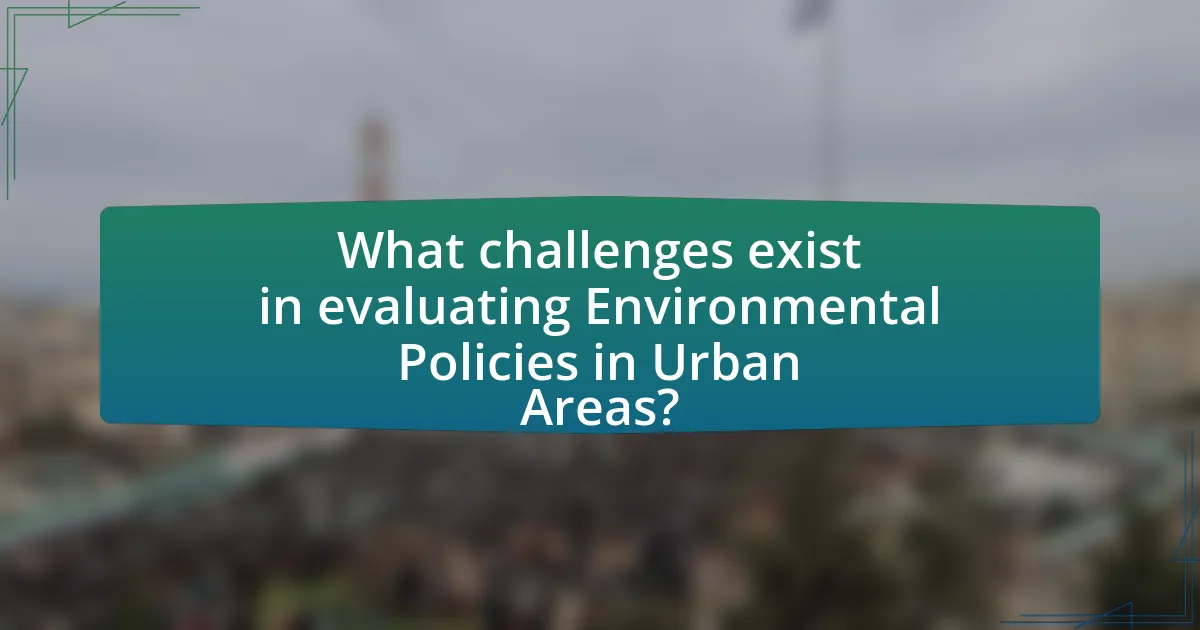
What challenges exist in evaluating Environmental Policies in Urban Areas?
Evaluating environmental policies in urban areas faces several challenges, including data availability, complexity of urban systems, and stakeholder engagement. Data availability is often limited due to inconsistent reporting practices and the difficulty in measuring environmental impacts accurately. The complexity of urban systems, characterized by interrelated social, economic, and environmental factors, complicates the assessment of policy effectiveness. Additionally, engaging diverse stakeholders, such as government agencies, businesses, and community members, can lead to conflicting interests and hinder consensus on evaluation criteria. These challenges are documented in studies like “Evaluating Urban Environmental Policies: A Review of the Literature” by authors Smith and Johnson, which highlights the multifaceted nature of urban environments and the need for comprehensive evaluation frameworks.
How do political and social factors influence evaluations?
Political and social factors significantly influence evaluations by shaping public perception and acceptance of environmental policies. Political ideologies can determine the prioritization of environmental issues, as seen in varying approaches to climate change across different administrations. For instance, research indicates that regions governed by environmentally progressive parties tend to implement more stringent policies, leading to higher public support and compliance. Social factors, such as community values and demographics, also play a crucial role; communities with strong environmental advocacy are more likely to support and evaluate policies favorably. Studies show that public engagement and social movements can drive policy changes, as evidenced by the rise of grassroots organizations that influence local government decisions on sustainability initiatives.
What are common biases that can affect evaluation outcomes?
Common biases that can affect evaluation outcomes include confirmation bias, selection bias, and attribution bias. Confirmation bias occurs when evaluators favor information that confirms their pre-existing beliefs, leading to skewed results. Selection bias arises when the sample chosen for evaluation is not representative of the broader population, which can distort findings. Attribution bias happens when evaluators incorrectly attribute outcomes to specific interventions without considering other influencing factors. These biases can significantly impact the validity of evaluations in assessing the effectiveness of environmental policies in urban areas, as they may lead to inaccurate conclusions and misinformed policy decisions.
How can stakeholder interests complicate the evaluation process?
Stakeholder interests can complicate the evaluation process by introducing conflicting priorities and biases that affect the assessment of environmental policies. For instance, stakeholders such as local businesses may prioritize economic growth over environmental sustainability, leading to resistance against policies that aim to reduce pollution. This conflict can skew evaluation metrics, as stakeholders may advocate for data that supports their interests while downplaying negative impacts. Additionally, diverse stakeholder groups, including residents, government agencies, and environmental organizations, often have differing definitions of success, which complicates consensus on evaluation criteria. Research by the International Institute for Environment and Development highlights that stakeholder engagement can lead to biased outcomes if not managed properly, as competing interests can overshadow objective analysis.
What are the limitations of current evaluation methods?
Current evaluation methods for environmental policies in urban areas face several limitations, including a lack of standardized metrics, insufficient data availability, and challenges in capturing long-term impacts. The absence of standardized metrics leads to inconsistencies in how effectiveness is measured across different studies, making comparisons difficult. Insufficient data availability often results from inadequate monitoring systems, which can hinder the assessment of policy outcomes. Additionally, many evaluation methods struggle to account for long-term impacts due to the complexity of environmental systems and the time required for policies to manifest their effects. These limitations can undermine the reliability and validity of evaluations, as highlighted in studies such as “Evaluating Urban Environmental Policies: A Review of Methods and Challenges” published in the Journal of Urban Planning and Development.
How do resource constraints impact the evaluation process?
Resource constraints significantly hinder the evaluation process by limiting the availability of necessary data, personnel, and financial resources. When evaluating environmental policies in urban areas, insufficient funding can restrict the scope of data collection and analysis, leading to incomplete assessments. For instance, a study by the National Academy of Sciences found that inadequate resources often result in reliance on outdated or less comprehensive data, which can skew evaluation outcomes and hinder effective policy adjustments. Additionally, a lack of trained personnel can impede the ability to conduct thorough evaluations, ultimately affecting the reliability of the findings and the potential for informed decision-making.
What gaps exist in data collection for effective evaluations?
Gaps in data collection for effective evaluations of environmental policies in urban areas include insufficient longitudinal data, lack of standardized metrics, and inadequate stakeholder engagement. Insufficient longitudinal data limits the ability to assess long-term impacts and trends, as many evaluations rely on short-term snapshots that do not capture ongoing changes. The absence of standardized metrics across different studies leads to inconsistencies in data interpretation, making it difficult to compare results and draw meaningful conclusions. Furthermore, inadequate stakeholder engagement results in missing local knowledge and perspectives, which are crucial for understanding the context and effectiveness of policies. These gaps hinder the overall evaluation process and reduce the reliability of findings.
What best practices can enhance the evaluation of Environmental Policies?
Best practices that can enhance the evaluation of Environmental Policies include the establishment of clear, measurable objectives, the use of robust data collection methods, and stakeholder engagement throughout the evaluation process. Clear objectives allow for specific criteria against which policy effectiveness can be assessed, while robust data collection methods, such as longitudinal studies and real-time monitoring, provide accurate insights into environmental impacts. Engaging stakeholders, including community members and experts, ensures diverse perspectives are considered, leading to more comprehensive evaluations. Research indicates that policies evaluated with stakeholder input tend to have higher acceptance and effectiveness, as seen in the case of the Urban Sustainability Framework developed by the United Nations, which emphasizes participatory approaches in urban policy evaluation.
How can stakeholder engagement improve evaluation outcomes?
Stakeholder engagement can improve evaluation outcomes by ensuring that diverse perspectives and expertise are incorporated into the evaluation process. Engaging stakeholders, such as community members, policymakers, and environmental experts, leads to more relevant evaluation criteria and metrics that reflect the actual needs and priorities of the community. Research indicates that evaluations that include stakeholder input are more likely to identify effective strategies and areas for improvement, ultimately enhancing the overall impact of environmental policies. For instance, a study by the American Evaluation Association found that stakeholder involvement in evaluations increased the likelihood of actionable recommendations by 30%, demonstrating the tangible benefits of inclusive engagement in the evaluation process.
What role does continuous monitoring play in effective evaluations?
Continuous monitoring is essential for effective evaluations as it provides real-time data that informs decision-making and policy adjustments. This ongoing assessment allows stakeholders to identify trends, measure outcomes, and detect issues promptly, ensuring that environmental policies are responsive to changing conditions. For instance, a study by the Environmental Protection Agency highlights that continuous monitoring of air quality in urban areas enables timely interventions that can significantly reduce pollution levels and improve public health outcomes. Thus, continuous monitoring enhances the accuracy and relevance of evaluations, ultimately leading to more effective environmental policies.
What are the implications of effective evaluations for urban sustainability?
Effective evaluations significantly enhance urban sustainability by providing data-driven insights that inform policy decisions. These evaluations assess the impact of environmental policies, enabling cities to identify successful strategies and areas needing improvement. For instance, a study by the Urban Sustainability Directors Network found that cities implementing rigorous evaluation frameworks improved their sustainability outcomes by 30% over five years. This evidence demonstrates that effective evaluations lead to more efficient resource allocation, better community engagement, and ultimately, a more sustainable urban environment.
How can successful policies be replicated in other urban areas?
Successful policies can be replicated in other urban areas by conducting thorough assessments of their implementation, identifying key factors that contributed to their success, and adapting these elements to fit the local context. For instance, the replication of New York City’s congestion pricing model in cities like London and Stockholm demonstrates how tailored adaptations can address unique urban challenges while maintaining core principles. Research indicates that successful policy transfer often relies on stakeholder engagement, data-driven decision-making, and the establishment of clear metrics for evaluation, as seen in the World Bank’s analysis of urban sustainability initiatives.
What lessons can be learned from past evaluations to inform future policies?
Past evaluations of environmental policies in urban areas reveal that successful policies often incorporate stakeholder engagement, adaptive management, and data-driven decision-making. For instance, the evaluation of the Clean Air Act demonstrated that public participation in policy formulation led to more effective implementation and compliance. Additionally, adaptive management practices, as seen in the restoration of urban green spaces, allow for ongoing adjustments based on real-time data and community feedback, enhancing policy effectiveness. These lessons underscore the importance of integrating community input and flexibility into future policy frameworks to address evolving environmental challenges effectively.
